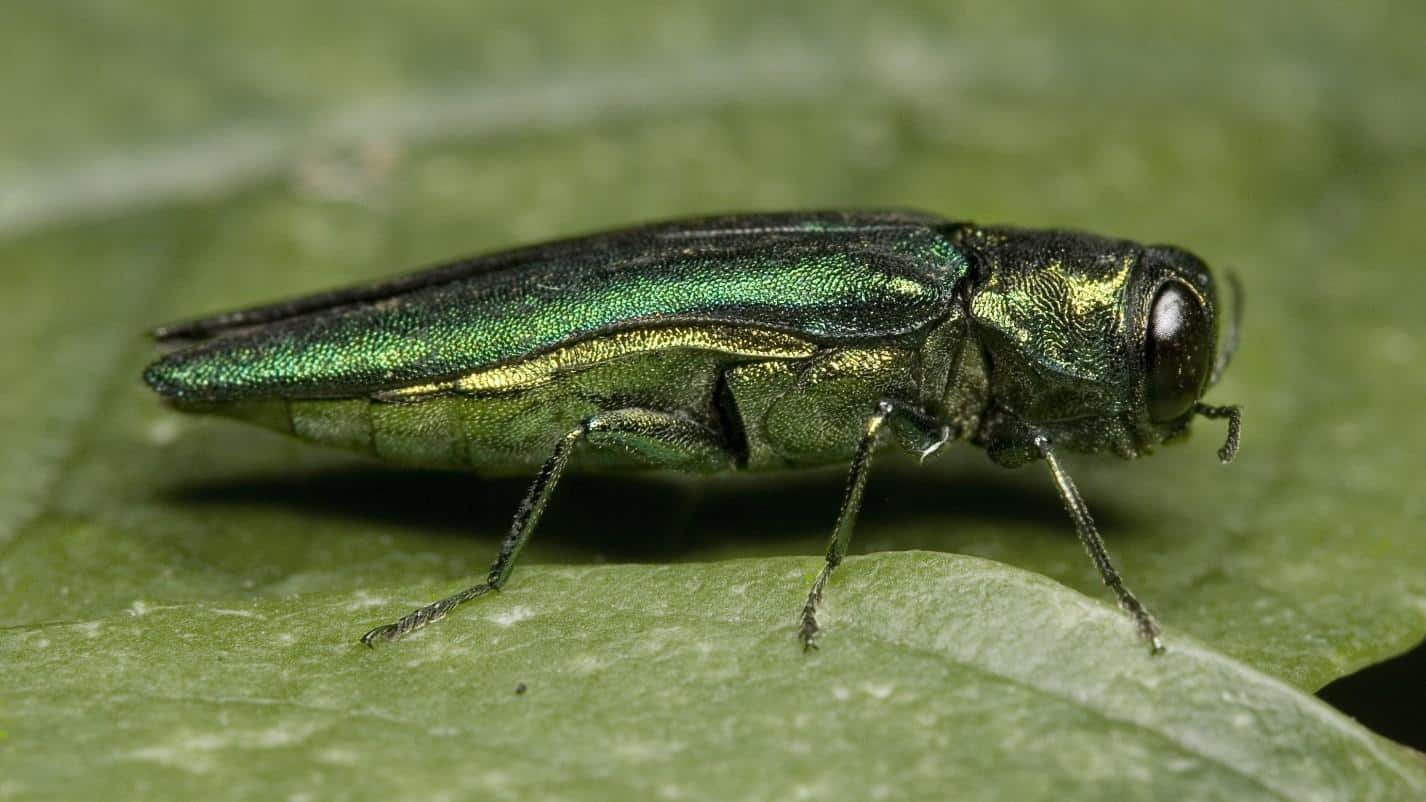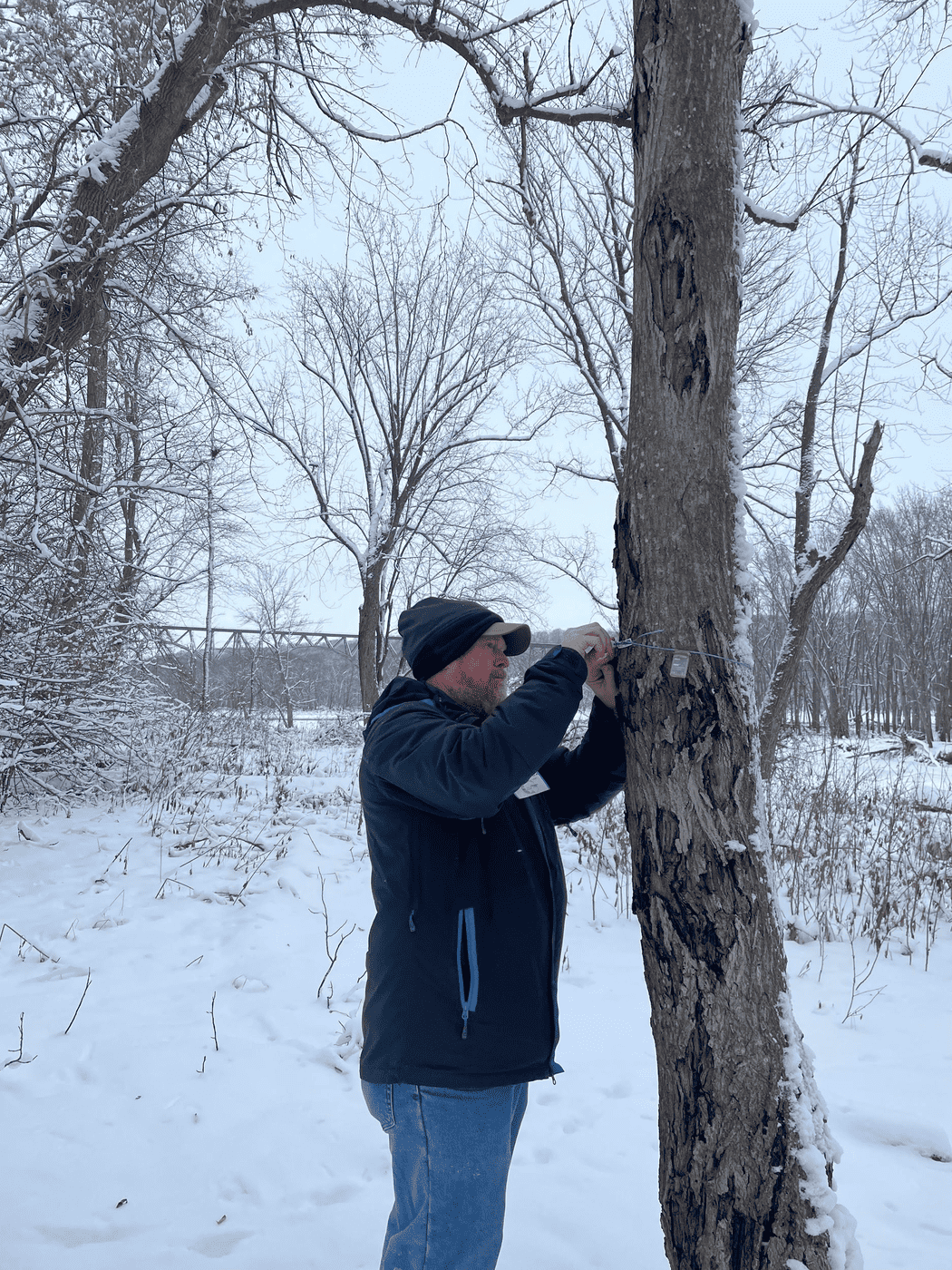Emerald Ash Borer–when hearing the name of these invasive insects, some may think of the beautiful jewel after which it is named. But those who are familiar with Emerald Ash Borer (EAB), know that the insects are far more destructive than they sound. Emerald Ash Borer are invasive insects from East Asia that were first discovered in the U.S. in 2002 in Detroit, Michigan. The insects are known to decimate ash tree populations by laying their eggs in the cracks of the outer bark layers of the trees. The eggs then hatch, and the bell-shaped larvae emerge and burrow into the trunk of the host tree, feeding on the wood as they go. Larvae weave back and forth in the wood and create s-shaped curves called galleries, which are indicative of EAB larvae. These galleries prevent the flow of water and nutrients in a tree, ultimately leading to its death. In the fall, after 1-2 years of feeding, the larvae will burrow deep in the wood and create a chamber, where they will spend the winter pupating to transform into mature, adult beetles. These adult beetles will then emerge from the trees in the spring to find another host tree and continue their life cycle. Adult emerald ash borer insects vary from ⅜ to ½ inch long, which is about the size of a penny. They have bright green, metallic wings and long slender bodies.

Aside from mountain ash and prickly ash, all species of ash trees can be affected by an emerald ash borer infestation, making EAB a terrifying prospect for many midwesterners. According to the Wisconsin Department of Natural Resources, 7.8% of all trees in Wisconsin are ash trees. EAB was first discovered in Wisconsin in 2008, and is currently present in 69 of the 72 counties in Wisconsin, with the highest concentration of EAB being present in the southern portion of the state. In Polk County specifically, emerald ash borer was first detected in the town of Osceola in April 2023, making Polk county the 68th county in Wisconsin to have EAB. According to the Minnesota Department of Agriculture, EAB was first discovered in Minnesota in 2009 in St. Paul, and is now present in 45 of the 87 counties in Minnesota.

Since the emergence of the emerald ash borer as an invasive insect in North America, many questions have been raised about EAB’s ability to survive the cold winter months up north. Emerald ash borer larvae, similar to other insect larvae, produce special compounds, such as alcohols or sugars, that act as an antifreeze to prevent their internal fluids from freezing in the winter. However, such as with antifreeze, there is a certain temperature at which those compounds stop working, causing the insects to freeze to death. According to research conducted by the U. S. Forest Service and the Minnesota Department of Agriculture, the super-cooling temperature, or the temperature at which emerald ash borer die, is -13°F. Since 2014, Wild Rivers Conservancy, along with National Park Service staff of the St. Croix National Scenic Riverway, have been deploying temperature loggers at 10 sites along the St. Croix riverway to record the temperature of the sites from December until March. The goal of this study is to find stands of ash trees throughout the riverway that experience these super-cooling temperatures that are capable of killing the insects. The temperature data is collected and sent to researchers at the University of Minnesota, who are attempting to develop controls for the invasive insect.
As with all invasive species, it is important for everyone to do their part to prevent the spread of EAB. One of the most important things you can do is avoid moving firewood or ash wood products from one place to another. This is because EAB eggs and larvae can survive in wood for up to two years. In fact, emerald ash borer are believed to have been first introduced to North America in wood products that had EAB larvae inside. Some additional actions to take are to inform others about the importance of not moving firewood and to keep up to date on new EAB infestations in your state. And for those with ash trees in their yard or property, one way to prevent EAB infestations before they occur is simply to apply a chemical treatment to the tree, repeating once every 2-3 years. The National Park Service is planning on treating several ash trees on park service property in the coming year, including a few trees at Osceola landing.
Additional resources on emerald ash borer and its impacts can be found on both the Wisconsin and Minnesota Department of Natural Resources websites, as well as on the University of Minnesota extension website.
